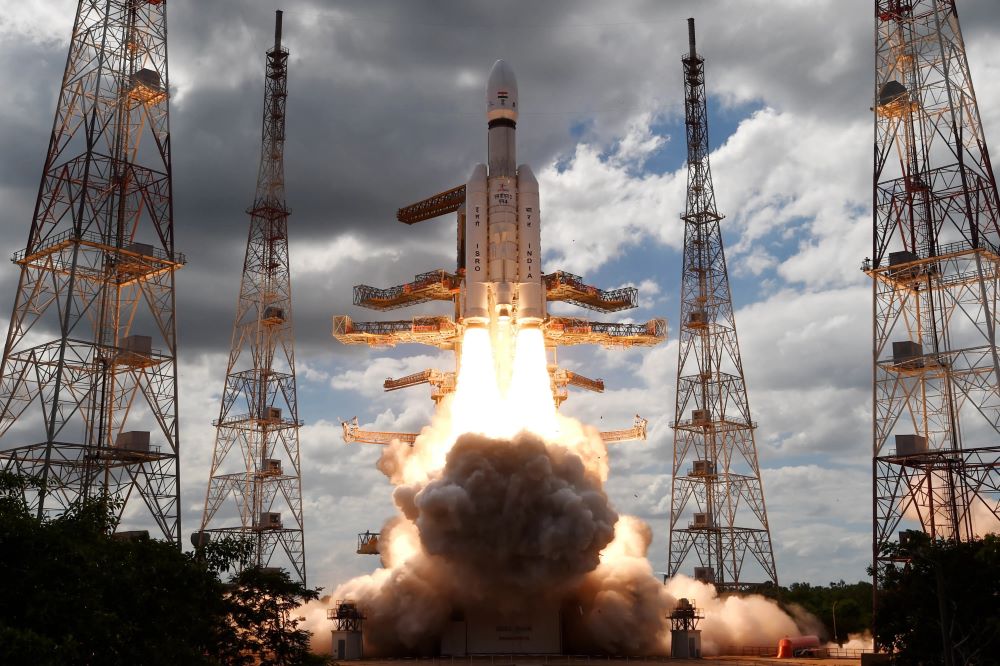On July 14, 2023, at 2:35 pm Indian Standard Time (5:05 am EST), the Indian Space Resource Organisation (ISRO) successfully launched their Chandrayaan-3 spacecraft from the Satish Dhawan Space Center, which is the primary spaceport of the ISRO. The goal of the mission is to put India’s first lander (Vikram) and rover (Pragyan) on the lunar surface and is scheduled to touch down on the Moon on August 23, 2023. This mission comes after the ISRO’s Chandrayaan-2 Vikram lander crashed on the Moon on September 6, 2019, due to a last-minute guidance software glitch. While the ISRO indicated everything was going according to plan, they unexpectedly lost contact with the Vikram lander approximately 2.1 kilometers (1.3 miles) above the lunar surface.
Following in its predecessor’s footsteps, Chandrayaan-3 will attempt to land Vikram and Pragyan near the lunar south pole in hopes of using their respective scientific payloads for conducting in situ experiments, analysis, and observations to gain insights into the Moon’s composition. These include gaining insights into the lunar surface composition, presence of water ice in the lunar regolith, the history of impacts on the Moon, and the Moon’s atmospheric evolution. The spacecraft is comprised of the Propulsion Module and Lander Module, where the former’s task is to carry the Lander Module from launch injection to Lunar orbit, and the Lander Module is comprised of the Vikram lander and Pragyan rover.

The Vikram lander scientific payload consists of the Radio Anatomy of Moon Bound Hypersensitive ionosphere and Atmosphere (RAMBHA) instrument, the Chandra Surface Thermophysical Experiment (ChaSTE), the Instrument for Lunar Seismic Activity (ILSA), the Langmuir Probe (LP), and NASA’s Laser Retroreflector Array (LRA). The Pragyan rover scientific payload consists of the Alpha Particle X-ray Spectrometer (APXS) and the Laser Induced Breakdown Spectroscope (LIBS).
The mission life for Vikram and Pragyan is expected to be one lunar day, or approximately 14 Earth days. Since the Moon always has one face towards the Earth and takes approximately 28 days to complete one orbit around the Earth, one lunar day is equivalent to 14 Earth days.
While Chandrayaan-2 met an unfortunate fate, the first mission of the Chandrayaan program was Chandrayaan-1, which consisted of a lunar orbiter and Moon Impact Probe (MIP) and launched from the Satish Dhawan Space Center on October 22, 2008. The spacecraft successfully entered lunar orbit on November 8, 2008, achieving final orbit insertion on November 12, 2008.
The MIP deployed from the spacecraft on November 14, and intentionally crashed near Shackleton Crater on the south pole of the Moon only thirty minutes later, during which time it continued to send back data which confirmed the existence of water ice within the lunar regolith. While the mission was expected to last approximately two years, the orbiter unexpectedly lost contact with ground control for unknown reasons on August 28, 2009, but a NASA radar determined in 2016 that the spacecraft was still in orbit around the Moon.
Despite the sudden end to the mission, the scientists determined that Chandrayaan-1 achieved 95 percent of its primary mission goals. These include using NASA’s Moon Mineralogy Mapper (M3) instrument to confirm the magma ocean hypothesis about the Moon and producing over 70,000 three-dimensional images of the lunar surface.
What new discoveries will Chandrayaan-3 with its Vikram lander and Pragyan rover make during its short mission to our nearest celestial neighbor? Only time will tell, and this is why we science!
As always, keep doing science & keep looking up!

